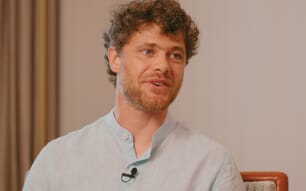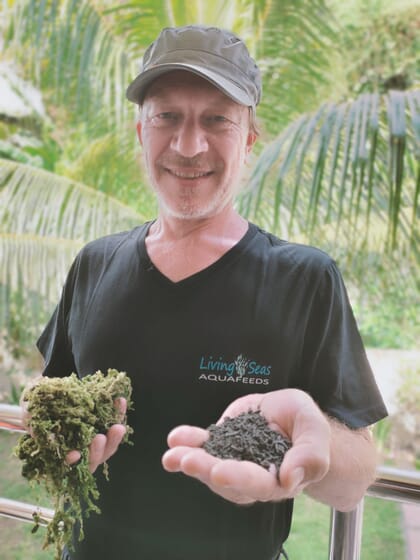
Based in Lombok, Indonesia, the startup uses local seaweeds to produce a functional shrimp feed called Shrimp Supplement
Can you tell us a little about yourself?
I am a fish farmer and established the world’s first organic-certified barramundi farm in Singapore. I went for certification as a way to differentiate my fish in a competitive market and since there was no template, I developed my own procedures and “natural” farming method that fitted with the Naturland organic aquaculture standard.
Undertaking this exercise made me a much better farmer and, because I now needed an organic certified feed – of which there was none – I got into making aquafeeds as well. I used some seaweeds and natural amino acids and developed a functional feed that, to my surprise, was the same price as conventional feeds but yielded a 30 percent improvement in feed conversion ratio (FCR). Fast forward a few years and I am not making feeds for my own fish but for other fish and shrimp farmers in Indonesia.
What exactly is Living Seas Aquafeeds doing?
We are based in Lombok, Indonesia, and are using local seaweeds to produce a functional shrimp feed that we call “Shrimp Supplement”. This is not a feed ingredient but an actual feed that the farmer mixes with their conventional feed.
We recommend that it is used to replace just 3 percent of their conventional feeds – some of the early adopters are using at a higher replacement rate, but we’ve found that 3 percent has provided the optimal value in terms of cost versus performance.
We have a range of feed sizes to match the size of the shrimp at each stage of the grow-out cycle. The formulation changes according to the size of the shrimp, to improve pond water quality and the digestion of conventional feed.

It was while establishing this organic fish farm that Hromatka got into making aquafeeds – as there was no organic-certified feed on the market – using some seaweeds and natural amino acids to develop a functional feed that yielded a 30 percent improvement in FCR
What else is in your Shrimp Supplement?
We also include minerals from a local volcano and a tiny sprinkling of mangrove leaves and then ferment the ingredients to make them bioavailable and “cold extrude” at ambient temperature, avoiding the high heat and pressure of conventional feed extrusion techniques and thereby keeping the bio-active molecules from the seaweeds and mangroves “alive”.
There’s no off-the-shelf equipment for doing this, we’re having to develop the equipment and process ourselves. We’re currently capable of producing a tonne of feed a day, but we’ll scale as we grow the market.
What impact does it have on the shrimp?
Trials on our own farm have led to an improvement in the water quality and stability, as well as increased shrimp stamina and vigour. This has resulted in a 15 percent improvement in survival and growth rates and a decrease in the amount of conventional feed that the farmer must buy, which is the most significant cost to shrimp production.
We have found FCRs have improved by 12 percent and the carbon footprint can be reduced by up to 18 percent, and the feed also appears to more palatable to shrimp than conventional feeds.
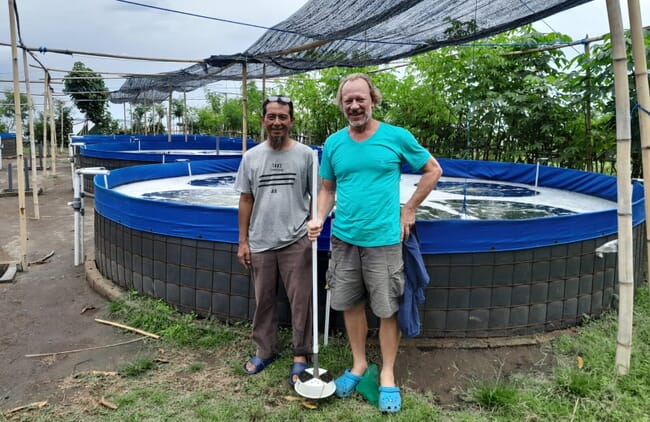
It's here that the duo conduct rapid feed trials of their functional shrimp feed, Shrimp Supplement
Are there any other benefits?
By sourcing our ingredients locally, we are reducing the use of imported soybean meal and fishmeal in the total shrimp’s diet and are putting money back to coastal communities in Indonesia.
Another interesting part is our use of mangrove leaves, which we pay local mangrove forest owners to collect, which encourages them to preserve their mangroves, since they can see revenues from their intact forest and thereby disincentivise them to destroy it by turning the trees into charcoal.
How did you develop your product?
My partner, Ghazan – who is Indonesian and brings experience of 30 years of running shrimp farms and hatcheries – and I have a lot of applied aquaculture knowledge and have conducted full literature reviews of the little research that has been done with seaweeds in aquafeeds, this is then followed by a lot of trial and error. We run our own experimental shrimp farm that we call our Living Seas Lab and continuously trial various formulations of our Shrimp Supplement to optimise the positive effects.
Our farm consists of round tanks and the setup allows us to do rapid trials and prototypes, by running multiple iterations at the same time.
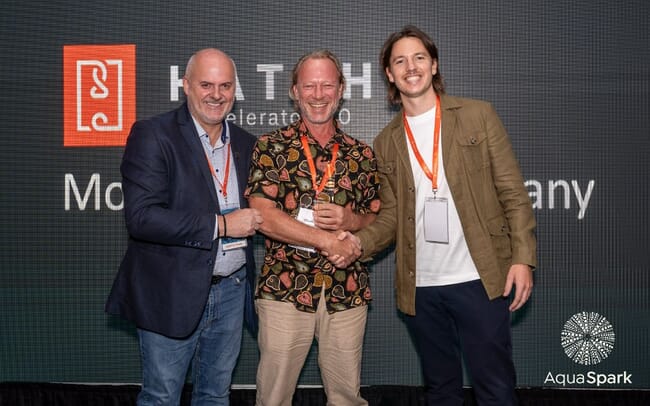
At the end of Hatch's latest accelerator, Living Seas Aquafeeds was voted "most investable company" out of the ten participating companies
You were recently voted the “most investable company” in the latest Hatch Accelerator. What made you stand out?
Out of the ten companies who were selected to participate in the accelerator, three of us were seaweed-focused, so there’s obviously a lot of interest in the sector from investors. I think investors liked that Living Seas Aquafeeds is an impact-driven company. And, since the demo day was held in Singapore and I told my Singapore fish farming story as part of my pitch, I think the local crowd could identify with me and appreciate my industry experience.
What did you learn from your participation in the accelerator?
It was very fast-paced and a lot of work, but my own learning and growth was immense. Hatch’s industry connections are vast, so we had leaders in various fields of aquaculture as mentors and introductions to people who can help our companies grow. I was also able to learn a lot from all of my fellow cohort entrepreneurs.
What are your future plans for Living Seas Aquafeeds?
We will continue to scale up production and distribution of our Shrimp Supplement. Aquaculture is generally a risky endeavour, so farmers are a cautious bunch. As a result, we give our feed to farmers to try out in one or two ponds for a growing cycle and let them see the improvements that it can make to their bottom line. This is the most important criterion for shrimp farmers, especially in the light of recent low shrimp prices.
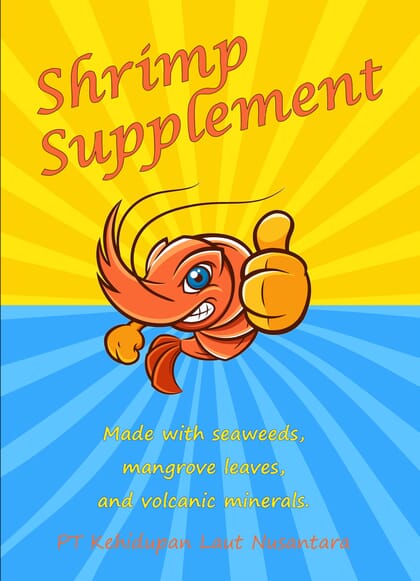
Made with local seaweeds, mangrove leaves and volcanic minerals, Shrimp Supplement is a functional feed that farmers mix with their conventional feed at a recommended rate of just 3 percent
We also have a lobster and crab feed that we are introducing to the market at the end of this year which improves growth and can replace traditional “trash fish” feed. We are also trialling a barramundi feed and see a lot of exciting products to introduce to shrimp and fish farmers.
The business has been entirely self-funded to date but, in order to scale, we’ll be looking to raise around $500,000 from impact investors at the start of next year.
What is the most satisfying part of your job?
I get a lot of satisfaction from paying seaweed farmers and custodians of mangroves for their products, turning these local natural ingredients into a feed item, and then hearing how this product has really had a positive impact on the farms’ productivity.
I think of myself as a chef for shrimp, so it is also really great to see that they prefer the feed that I make over mass-produced factory feeds.
Living Seas Aquafeeds is part of Hatch's investment portfolio, but The Fish Site retains editorial independence.


